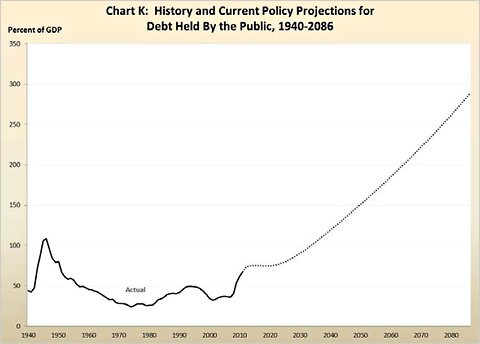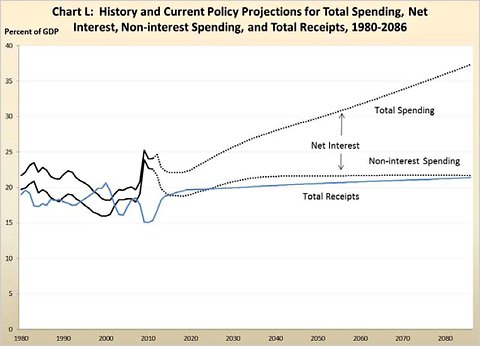
Bruce Bartlett held senior policy roles in the Reagan and George H.W. Bush administrations and served on the staffs of Representatives Jack Kemp and Ron Paul. He is the author of the coming book “The Benefit and the Burden: Tax Reform – Why We Need It and What It Will Take.”
In our personal lives, we all understand that debts may take different forms. They aren’t limited only to credit cards or loans taken out from banks; they consist of various promises and financial obligations as well.
Today’s Economist
Perspectives from expert contributors.
These might include commitments to pay for a daughter’s wedding or a child’s graduate school education, to provide the down payment on a sibling’s house or to care for aged parents. While these debts may not show up on anyone’s formal balance sheet, families are well aware of them, and failure to live up to them can be very costly indeed.
So, too, with the federal government. The national debt, which is the object of almost obsessive attention these days, is like a bank loan. It is an important part of national indebtedness, but only a small part. The vast bulk of the true debt is in the form of commitments to pay future benefits to retired federal employees, veterans, and Social Security and Medicare beneficiaries.
These commitments are generally invisible because the federal government operates on a cash basis. The federal budget is concerned only with income and outgo between two points in time — from Oct. 1 to Sept. 30, the fiscal year. Promises to pay benefits in the future generally show up in the budget only when those benefits are actually paid.
For many years, it was almost impossible even to find a list of the federal government’s financial commitments.
In 1949, the Hoover Commission recommended that the government move toward accrual accounting, which corporations are required to use, and book the full cost of programs on an annual basis. It wasn’t until 1966 that Congress required the Treasury Department to publish the data.
But it was available only as an obscure mimeographed document, difficult to obtain, called the Statement of Liabilities and Other Financial Commitments of the United States Government, known only to budget experts.
In 1977, the General Accounting Office and the Treasury published the first consolidated financial statement of the United States government. It was limited in scope, and insufficient data existed to calculate many of the government’s assets and liabilities, but it was an important start to providing a complete picture of federal indebtedness.
The successor to the consolidated financial statement is now called the Financial Report of the United States Government. The edition for the 2011 fiscal year was published on Dec. 23 by the Treasury’s Financial Management Service to no fanfare.
The Obama administration, like previous administrations, had little interest in telling the American people that their debt problem was vastly worse than they thought. It buried the report on a day when most reporters were preparing for the holidays and unlikely to pore through a 254-page document filled with long columns of numbers punctuated with footnotes and accounting jargon.
Predictably, the financial report was ignored. Even The New York Times took no notice of it.
According to the report, the federal debt — simply the cumulative value of all past budget deficits less surpluses — was $10.2 trillion on Sept. 30. But the government also owed $5.8 trillion to federal employees and veterans. Social Security’s unfunded liability — promised benefits over expected Social Security revenues — was $9.2 trillion over the next 75 years, or about 1 percent of the gross domestic product. Medicare’s unfunded liability was $24.6 trillion, or 3 percent of G.D.P.
Altogether, the Treasury reckons the government’s total indebtedness at $51.3 trillion – five times the size of the national debt. This would be an unbearable burden if it had to be paid by the current generation out of current resources, for it approximately equals the entire net worth of American households.
But national debts, of course, will also be paid by future generations out of future output. Those generations will also inherit most of the assets of the current generation, from which future commitments can be financed. For example, future generations will inherit the Treasury’s bonds as well as the responsibility for paying interest on them.
Even so, the Treasury projects that within a generation the federal debt will rise to 100 percent of G.D.P. as future commitments become part of annual spending over and above projected revenues.
 Financial Report of the United States Government
Financial Report of the United States Government
Although it is commonly believed that our fiscal problem is purely one of spending, the financial report shows that this is not necessarily the case. The really rapid growth of future spending is not for programs but for interest on the debt.
In other words, it would not be nearly enough just to balance the budget. The federal government would have to begin running a surplus immediately and do so continuously for the next 75 years to prevent the debt/G.D.P. ratio from rising.
 Financial Report of the United States Government
Financial Report of the United States Government
The critical point is that interest on the debt is not just another government program that can be cut. It can be reduced only by running a budget surplus, selling assets to reduce principal or reducing the interest paid on the debt.
With interest rates at historical lows and the vast bulk of the debt in the form of short-term securities that roll over rapidly, the figures in the chart above are probably conservative. It is not hard to envision a situation in which interest on the debt rises more quickly than spending can be cut — a problem many European nations are in today.
It’s essential that we strive to overcome budgetary myopia. Our debts are manageable, but only if we take a long-run perspective.
Article source: http://feeds.nytimes.com/click.phdo?i=6cab290c8ddf534aab537bacae62b751
Speak Your Mind
You must be logged in to post a comment.